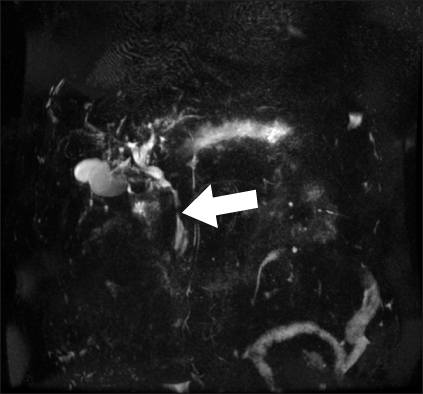Korean J Gastroenterol.
2012 Jun;59(6):445-447. 10.4166/kjg.2012.59.6.445.
Portal Bilopathy
- Affiliations
-
- 1Department of Internal Medicine, Keimyung University School of Medicine, Daegu, Korea. chung50@dsmc.or.kr
- KMID: 1792852
- DOI: http://doi.org/10.4166/kjg.2012.59.6.445
Abstract
- No abstract available.
MeSH Terms
Figure
Reference
-
1. Gibson JB, Johnston GW, Fulton TT, Rodgers HW. Extrahepatic portal-venous obstruction. Br J Surg. 1965. 52:129–139.2. Williams SM, Burnett DA, Mazer MJ. Radiographic demonstration of common bile duct varices. Gastrointest Radiol. 1982. 7:69–70.3. Bayraktar Y, Balkanci F, Ozenc A, et al. The "pseudo-cholangiocarcinoma sign" in patients with cavernous transformation of the portal vein and its effect on the serum alkaline phosphatase and bilirubin levels. Am J Gastroenterol. 1995. 90:2015–2019.4. Malkan GH, Bhatia SJ, Bashir K, et al. Cholangiopathy associated with portal hypertension: diagnostic evaluation and clinical implications. Gastrointest Endosc. 1999. 49:344–348.5. Chandra R, Kapoor D, Tharakan A, Chaudhary A, Sarin SK. Portal biliopathy. J Gastroenterol Hepatol. 2001. 16:1086–1092.6. Bayraktar Y, Balkanci F, Kayhan B, Ozenç A, Arslan S, Telatar H. Bile duct varices or "pseudo-cholangiocarcinoma sign" in portal hypertension due to cavernous transformation of the portal vein. Am J Gastroenterol. 1992. 87:1801–1806.7. Nagi B, Kochhar R, Bhasin D, Singh K. Cholangiopathy in extrahepatic portal venous obstruction. Radiological appearances. Acta Radiol. 2000. 41:612–615.8. Dhiman RK, Chawla Y, Vasishta RK, et al. Non-cirrhotic portal fibrosis (idiopathic portal hypertension): experience with 151 patients and a review of the literature. J Gastroenterol Hepatol. 2002. 17:6–16.9. Khuroo MS, Yattoo GN, Zargar SA, et al. Biliary abnormalities associated with extrahepatic portal venous obstruction. Hepatology. 1993. 17:807–813.10. Condat B, Vilgrain V, Asselah T, et al. Portal cavernoma-associated cholangiopathy: a clinical and MR cholangiography coupled with MR portography imaging study. Hepatology. 2003. 37:1302–1308.11. Dhiman RK, Puri P, Chawla Y, et al. Biliary changes in extrahepatic portal venous obstruction: compression by collaterals or ischemic? Gastrointest Endosc. 1999. 50:646–652.12. Sharma M, Pathak A. Intracholedochal varices in portal hypertensive bilopathy. European J Radiol Extra. 2009. 72:e119–e123.13. Palazzo L, Hochain P, Helmer C, et al. Biliary varices on endoscopic ultrasonography: clinical presentation and outcome. Endoscopy. 2000. 32:520–524.14. Umphress JL, Pecha RE, Urayama S. Biliary stricture caused by portal biliopathy: diagnosis by EUS with Doppler US. Gastrointest Endosc. 2004. 60:1021–1024.
- Full Text Links
- Actions
-
Cited
- CITED
-
- Close
- Share
- Similar articles
-
- A Case of Esophageal Variceal Bleeding in a Child Secondary to Portal Hypertension Associated with Cavernous Transformation of the Portal Vein Suggesting Extrahepatic Portal Obstruction
- Preduodenal Portal Vein Associated with Duodenal Obstruction: A case report
- Blood flow volume difference (P-SS) between the portal vein and thesum of splenic vein and superior mesenteric vein in portal hypertension
- Portal hypertension in children
- Comparison of portal CT and indirect portography in hepatic masses





